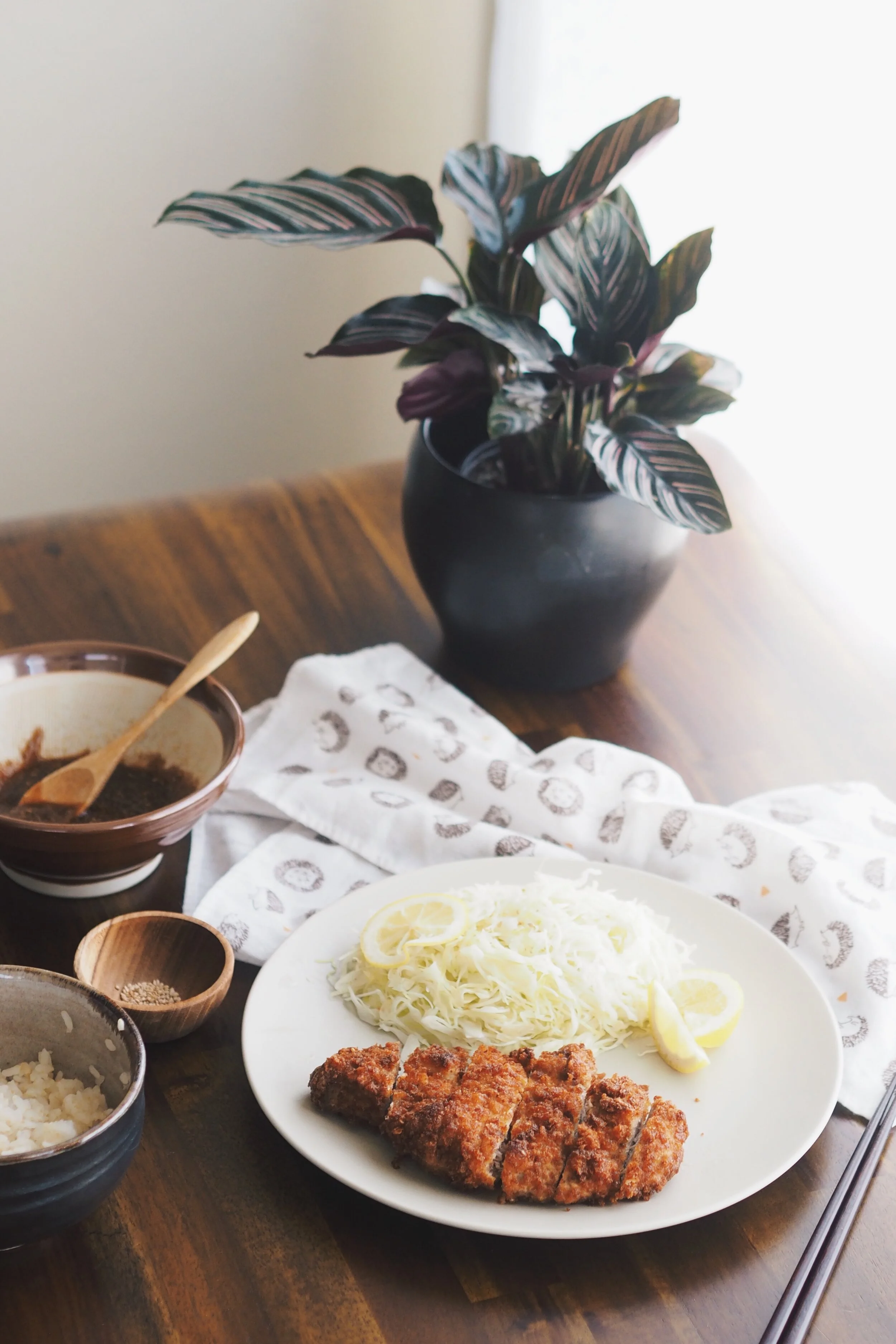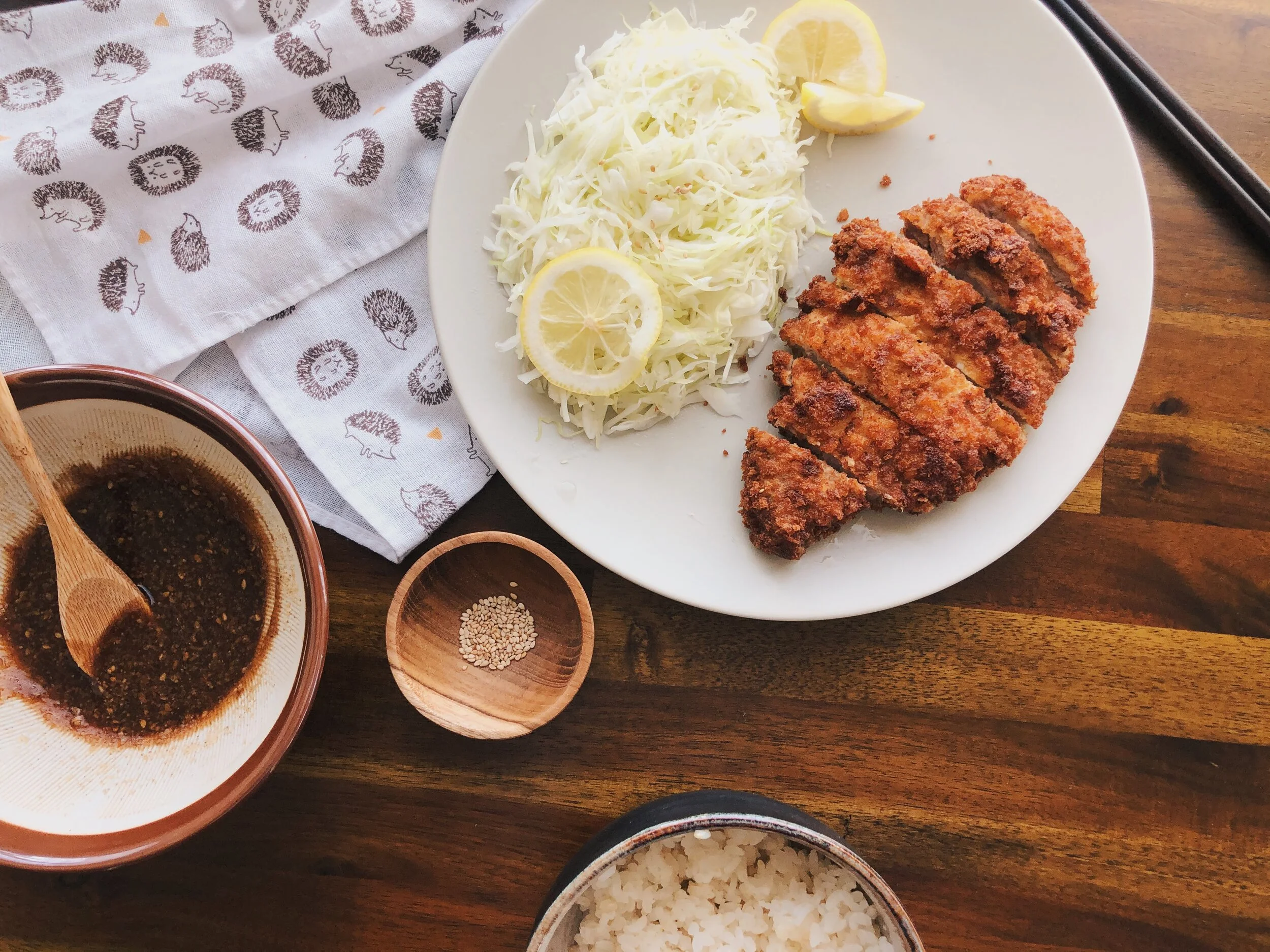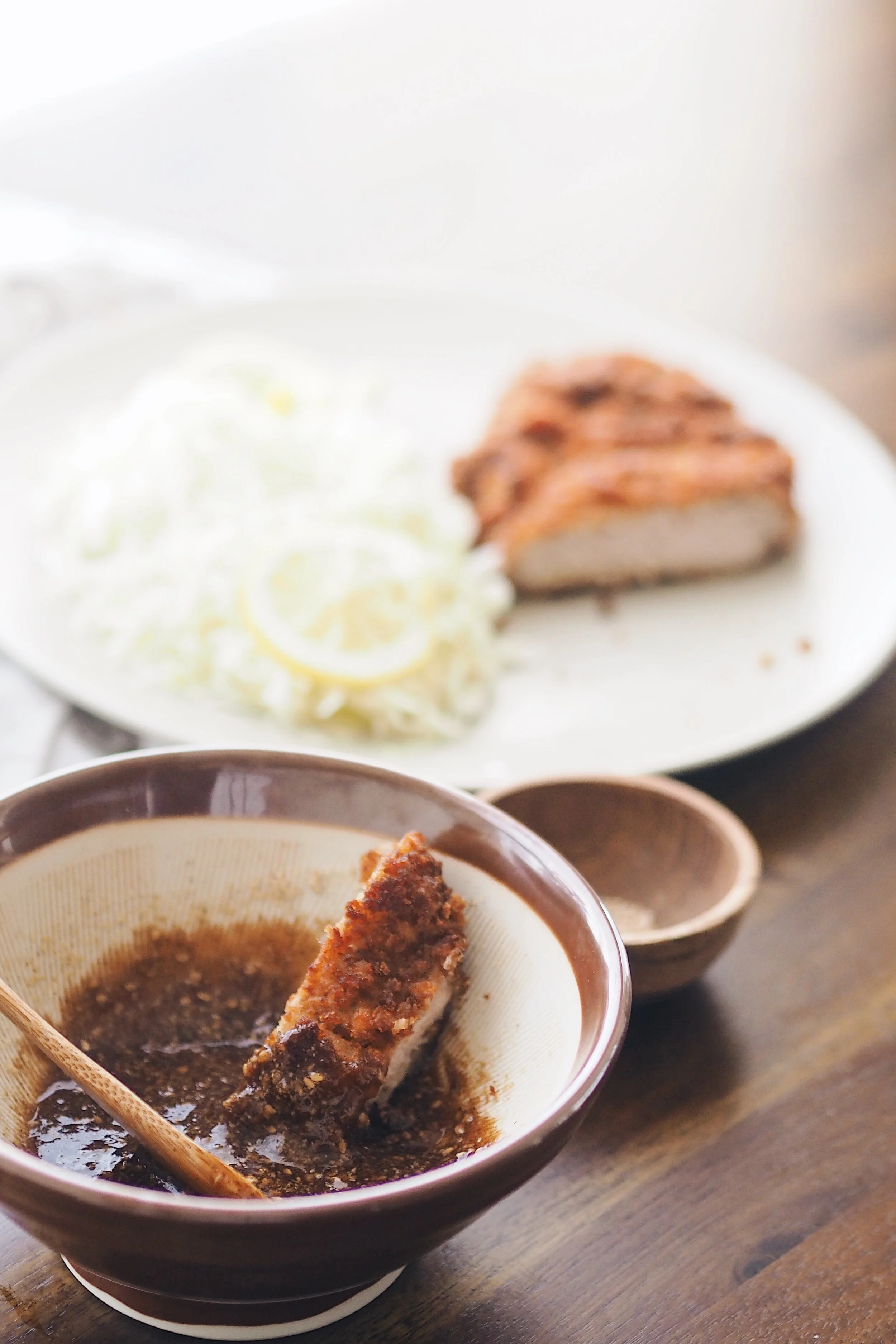Tonkatsu Set
Impossible to distinguish from non-gluten-free versions, this tonkatsu recipe was inspired from learning that many tonkatsu restaurants in Japan use fresh breadcrumbs to coat their pork cutlets.
TONkatsu SET RECIPE
makes 4 servings
Ingredients
tonkatsu
1¼ lb pork tenderloin with dark meat¹, about four ¾-inch slices
¼ cup gluten-free flour⁴
1 egg
5-6 slices of gluten-free bread, or 2 cups gluten-free breadcrumbs
rice bran oil², for deep frying
cabbage salad
½ cabbage, shredded
3 tbsp vegetable oil
1½ tbsp mirin
2 tbsp honey
2 tbsp sesame oil
2 tbsp rice vinegar
½ tsp white sesame seeds, toasted
for the sauce
2 tsp hot mustard³
3 tbsp white sesame seeds
½ cup katsu sauce
Suribachi set, like this one
for serving
Japanese rice, steamed
directions
Begin by using a food processor to make the bread crumbs. Chop up a few slices of either fresh or frozen bread and fill the food processor with the bread chunks, pulsing several times until the crumbs reach a size of a peppercorn, with several larger and smaller pieces. Take care to not over-process the breadcrumbs, and err on the larger side.
Slice the cabbage into shreds using a cabbage slicer or a mandoline; the strips should be as thin as possible for a more pleasant mouthfeel. Place in a large bowl and set aside.
Next, gather the tonkatsu ingredients and set up your dredging station. Put the flour in a medium bowl, whisk the egg in another medium bowl, and spread a thick layer of breadcrumbs in a larger bowl. To create a cleaner and more efficient workspace, line up the bowls side by side so that the bowl of flour is on the left, the egg next, the breadcrumbs after, and lastly, a large plate or board to stack the breaded meat.
Dredge a piece of pork in the flour, flipping it in the bowl to make sure to fully cover the meat. Then, dip the dredged pork into the whisked egg. Make sure the meat is fully covered in the egg and allow the excess to drip off, before pressing it carefully into the bowl of breadcrumbs. Next, turn the meat over and press breadcrumbs into the other side, while also bringing up breadcrumbs to press on the edges. Lightly pat on breadcrumbs in any open spots. When fully coated, gently pick up the breaded pork and let any excess drop off. Transfer the tonkatsu onto the large plate, and repeat with the rest of the pieces of pork.
Fill a saucepan or pot with rice bran oil, pouring enough so that the tonkatsu will be submerged, about 2 to 3 inches of oil. I usually pour about 3½ cups of oil into a 1.5 quart saucepan. Heat the oil on medium until it comes to 325°F.
While the oil is heating, prepare the tonkatsu sauce and cabbage salad. To make the sauce, start by toasting the sesame seeds in a small pan on medium heat, about 1 to 2 minutes. Keep a close watch on them, swirling the pan so that they do not brown or burn. When they smell fragrant and toasty, remove pan from heat and pour the seeds into the suribachi bowl. Set aside about half a teaspoon for the cabbage salad. With the sesame in the suribachi bowl, use the wooden pestle to crush the sesame seeds. When the seeds are finely ground and the wonderful, nutty fragrance of freshly ground sesame seeds has filled the air, pour the katsu sauce in and mix together. Set aside.
For the cabbage salad, whisk together the honey, mirin, vinegar, sesame oil, and vegetable oil in a small bowl, tasting and adjusting to your liking, then add the vinaigrette to the shredded cabbage. Toss until evenly combined. Take a 1 cup measuring cup and fill it generously, overflowing it with the cabbage salad, and drop on the plate you are serving the meal on. Mold the cabbage salad into a circular or oval shape with your fingers, and top with some toasted white sesame seeds.
Once the oil is at 325°F, it is ready for deep frying. If you do not own a candy thermometer, test to see if the oil is ready by dropping a breadcrumb in the oil. If it starts bubbling vigorously, then the oil is ready. If not, wait for 30 to 45 seconds and try again. When ready, using a pair of tongs, gently lower the tonkatsu into the oil. Depending on what size pot you are using, you can slip in a few more pieces to fry at the same time, provided that the temperature does not drop much. The oil should continue to bubble vigorously throughout the entire process. After a couple minutes, gently turn the tonkatsu over in the oil so that it cooks evenly on both sides. Cook for another 2 or so minutes, and transfer the finished tonkatsu to a cooling rack. The tonkatsu should look crunchy and be a dark golden brown color, but it won’t be done cooking on the inside; let the tonkatsu rest for at least 5 minutes before cutting. Repeat with with the rest of the breaded pork.
Cut the tonkatsu into 5 to 6 pieces by pressing the knife directly down instead of moving back and forth. This way, the breading will not come off. Transfer to the plate with the cabbage salad and serve immediately with a bowl of steamed rice, sesame katsu sauce, and hot mustard paste.
notes
1. The key is to select pork tenderloin that has about 30% dark meat; because of the ring of dark meat, the meat will be pretty tender already. If you’re unable to find pork tenderloin with section of dark meat, another option is to buy pork chop and slice the bone off. I would recommend against buying tenderloin that is mostly white meat, as it will come out dry, even if you tenderize it.
2. Rice bran oil is my favorite type of oil to deep fry with, and the one I usually use is Miyako Tempura Kome Abura 100% Pure Rice Bran Oil. I’ve used canola and sunflower oil on many occasions and have found that the best results come from the rice bran oil. Personally, I am not a fan of the scent of canola and other vegetable oils.
3. Hot mustard isn’t exactly spicy and surprisingly does not taste like mustard. It’s more of horseradish or wasabi nose clearing “spicy” and absolutely amazing when paired with tonkatsu sauce. S&B Oriental Hot Mustard Powder is the best, and it’s pretty easy to find in asian grocery stores. It comes as a powder, and you mix it with a bit of water (1:1 ratio) to create a paste.
4. I use whatever gluten-free flour I have on hand for the dredging. Lately, I’ve been using sorghum flour simply because I have an excess of it. I’ve also used rice flour, coconut flour, tapioca flour, and cassava flour in the past, and they all work well. Of course, if gluten isn’t an issue, all-purpose flour is what is typically used in most recipes.
5. I usually keep a freezer bag of already processed breadcrumbs in my freezer. Fresh breadcrumbs still tastes better, but it’s convenient to have the breadcrumbs on hand for whenever the urge strikes.
6. I don’t like to toss out a batch of oil after only one use, so I usually store and save the deep fry oil for later. After the oil cools completely, strain the oil to remove any katsu bits. Then, pour the strained oil into a plastic bottle and place in the freezer. I usually use each batch of oil 3 to 4 times before tossing.





